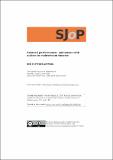Files in this item
Relaxed performance : audiences with autism in mainstream theatre
Item metadata
| dc.contributor.author | Fletcher-Watson, Ben | |
| dc.date.accessioned | 2016-08-23T08:30:29Z | |
| dc.date.available | 2016-08-23T08:30:29Z | |
| dc.date.issued | 2015-06-26 | |
| dc.identifier | 242478954 | |
| dc.identifier | 0b1ae7e2-e256-4969-8b18-1e7d9652bc5f | |
| dc.identifier.citation | Fletcher-Watson , B 2015 , ' Relaxed performance : audiences with autism in mainstream theatre ' , Scottish Journal of Performance , vol. 2 , no. 2 , pp. 61-89 . https://doi.org/10.14439/sjop.2015.0202.04 | en |
| dc.identifier.uri | https://hdl.handle.net/10023/9360 | |
| dc.description.abstract | Emerging less than a decade ago, ‘relaxed performances’ now take place at many theatres in the UK and USA. These events encourage attendance at mainstream productions by hitherto neglected audiences, particularly those with autism. The changes made may include reduced intensity of lighting and sound, the provision of visual stories to familiarise theatregoers with the venue and production, and trained staff on hand to assist visitors. This paper examines the rise in relaxed performance since 2009, providing a synopsis of current practice. A short case study of a relaxed performance of The Lion King then prompts three questions: what do autistic theatregoers want from a theatre performance? Do relaxed performances alter the conventions of live theatre? What is their impact on actors? The paper also considers the role of human rights in inclusive arts, and proposes several avenues for future research into this challenging and exciting movement. | |
| dc.format.extent | 260594 | |
| dc.language.iso | eng | |
| dc.relation.ispartof | Scottish Journal of Performance | en |
| dc.subject | Relaxed performance | en |
| dc.subject | Autism | en |
| dc.subject | Theatre | en |
| dc.subject | Autism-friendly | en |
| dc.subject | The Lion King | en |
| dc.subject | PN2000 Dramatic representation. The Theater | en |
| dc.subject.lcc | PN2000 | en |
| dc.title | Relaxed performance : audiences with autism in mainstream theatre | en |
| dc.type | Journal article | en |
| dc.contributor.sponsor | Economic & Social Research Council | en |
| dc.contributor.institution | University of St Andrews. University of St Andrews | en |
| dc.identifier.doi | 10.14439/sjop.2015.0202.04 | |
| dc.description.status | Peer reviewed | en |
| dc.identifier.grantnumber | RES-187-24-0014 | en |
This item appears in the following Collection(s)
Items in the St Andrews Research Repository are protected by copyright, with all rights reserved, unless otherwise indicated.

